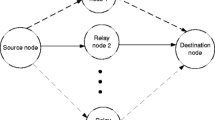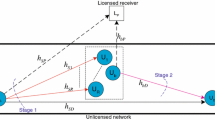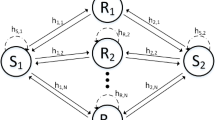Abstract
In this paper, we present analytical results on the effective capacity (EC) for a dual-hop cooperative network employing non-orthogonal multiple access and the decode-and-forward half-duplex relaying protocol. Assuming that wireless propagation is modelled by the Nakagami-m distribution, novel analytical results for the EC are deduced. These analytical results are further extended to the generalized fading channels, modeled by a mixture gamma distribution. Our proposed analysis is validated by numerical results and Monte-Carlo simulations. Besides, the numerically evaluated results have demonstrated the impact of various system-level parameters on the performance of the considered system, including the impact of fading, the power allocation coefficient and the delay constraints.





Similar content being viewed by others
Notes
An efficient method for the numerical evaluation of the bivariate G-function using Matlab is available in [13].
References
Hwang, E., Hao, X., & Atkin, G. E. (2023). Design of incidence matrices with limited constellation expansion in massive connectivity NOMA systems. IEEE Access, 11, 6524–6540.
Gao, R., Qi, P., & Zhang, Z. H. (2020). Performance analysis of spectrum sensing schemes based on energy detector in generalized Gaussian noise. Signal Processing, 181(2), 107893–107993.
Lei, H., et al. (2023). On secure CDRT with NOMA and physical-layer network coding. IEEE Transactions on Communications, 71(1), 381–396.
Wu, D., & Negi, R. (2003). Effective capacity: A wireless link model for support of quality of service. IEEE Transactions on Wireless Communications, 2(4), 630–643.
Shah, S. W. H., Mahboob-Ur-Rahman, M., Mian, A. N., Dobre, O. A., & Crowcroft, J. (2021). Effective capacity analysis of HARQ-enabled D2D communication in multi-tier cellular networks. IEEE Transactions on Vehicular Technology, 70(9), 9144–9159.
Shah, S. W. H., Mahboob-Ur-Rahman, M., Mian, A. N., Imran, A., Mumtaz, S., & Dobre, O. A. (2019). On the impact of mode selection on effective capacity of device-to-device communication. IEEE Wireless Communications Letters, 8(3), 945–948.
Shah, S. W. H., Mian, A. N., Mumtaz, S., Al-Dulaimi, A., Chih-Lin, I., & Crowcroft, J. (2022). Statistical QoS analysis of reconfigurable intelligent surface-assisted D2D communication. IEEE Transactions on Vehicular Technology, 71(7), 7343–7358.
Shah, S. W. H., Mian, A. N., & Crowcroft, J. (2020). Statistical QoS guarantees for licensed-unlicensed spectrum interoperable D2D communication. IEEE Access, 8, 27277–27290.
Shah, S. W. H., Pavan-Deram, S., & Widmer, J. (2023). On the effective capacity of RIS-enabled mmWave networks with outdated CSI. In IEEE Conference on Computer Communications (pp. 1–10).
Qiao, D., Gursoy, M. C., & Velipasalar, S. (2012). Effective capacity of two-hop wireless communication systems. IEEE Transactions on Information Theory, 59(2), 873–885.
Karatza, G. P., Peppas, K. P., & Sagias, N. C. (2018). Effective capacity of multisource multidestination cooperative systems under cochannel interference. IEEE Transactions on Vehicular Technology, 67(9), 8411–8421.
Peppas, K. P., Mathiopoulos, P. T., & Yang, J. (2016). On the effective capacity of amplify-and-forward multihop transmission over arbitrary and correlated fading channels. IEEE Wireless Communications Letters, 5(3), 248–251.
Peppas, K. P. (2012). A new formula for the average bit error probability of dual-hop amplify-and-forward relaying systems over generalized shadowed fading channels. IEEE Wireless Communications Letters, 1(2), 85–88.
Kanellopoulou, K. D., Peppas, K. P., & Mathiopoulos, P. T. (2020). Effective capacity of \(L_{p}\)-norm diversity receivers over generalized fading channels under adaptive transmission schemes. IEEE Transactions on Communications, 68(2), 1240–1253.
Yang, Y., Zhou, D. W., Zhan, D. C., Xiong, H., Jiang, Y., & Yang, J. (2023). Cost-effective incremental deep model: matching model capacity with the least sampling. IEEE Transactions on Knowledge and Data Engineering, 35(4), 3575–3588.
Li, X., Liu, H., Li, G., Liu, Y., Zeng, M., & Ding, Z. (2022). Effective capacity analysis of AMBC-NOMA communication systems. IEEE Transactions on Vehicular Technology, 71(10), 11257–11261.
Zeng, J., Xiao, C., Wu, T., Ni, W., Liu, R. P., & Guo, Y. J. (2023). Uplink non-orthogonal multiple access with statistical delay requirement: Effective capacity, power allocation, and \(\alpha \) fairness. IEEE Transactions on Wireless Communications, 22(2), 1298–1313.
Shah, S. W. H., Mahboob-Ur-Rahman, M., Mian, A. N., Dobre, O. A., & Crowcroft, J. (2021). Effective capacity analysis of HARQ-enabled D2D communication in multi-tier cellular networks. IEEE Transactions on Vehicular Technology, 70(9), 9144–9159.
Liu, H., Li, G., Li, X., Liu, Y., Huang, G., & Ding, Z. (2022). Effective capacity analysis of STAR-RIS-assisted NOMA networks. IEEE Wireless Communications Letters, 11(9), 1930–1934.
Atapattu, S., Tellambura, C., & Jiang, H. (2011). A mixture gamma distribution to model the SNR of wireless channels. IEEE Transactions on Wireless Communications, 10(12), 4193–4203.
Gradshteyn, I. S., & Ryzhik, I. M. (2007). Table of integrals, series, and products. Mathematics of Computation, 20(96), 1157–1160.
Agarwal, R. P., Bhatt, R. C., Pandey, R. C., & Srivastava, H. M. (1965). An extension of Meijer’s G-function. Proceedings of the National Academy of Sciences, India Part A.
Prudnikov, A. P. (1988). Integrals and series. American Journal of Physics, 56(10), 957–958.
Lei, H., Chao, G., Ansari, I. S., Guo, Y., Pan, G., & Qaraqe, K. A. (2016). On physical layer security over SIMO generalized-K fading channels. IEEE Transactions on Vehicular Technology, 65(9), 7780–7785.
Shah, S. W. H., Li, R., Rahman, M. M. U., Mian, A. N., Aman, W., & Crowcroft, J. (2021). Statistical QoS guarantees of a device-to-device link assisted by a full-duplex relay. Transactions on Emerging Telecommunications Technologies, 32(11), e4339.
Guo, N., Ge, J., Bu, Q., & Zhang, C. (2019). Multi-user cooperative non-orthogonal multiple access scheme with hybrid full/half-duplex user-assisted relaying. IEEE Access, 7, 39207–39226.
Acknowledgements
National Natural Science Foundation of China (Grant No. 61472343), Natural Science Foundation of Jiangsu Province (BK20170512) and Graduate International Academic Exchange Special Fund Projects of Yangzhou University support this work.
Funding
National Natural Science Foundation of China (Grant No. 61472343), Natural Science Foundation of Jiangsu Province (BK20170512).
Author information
Authors and Affiliations
Contributions
Jing Yang derived the main analytical results and wrote the main mauscript text. Yuxin Liu and Weiran Jiang were responsible for completing the numerical and Monte-Carlo simulation results. Jie Ding polished the manuscript. All authors reviewed the manuscript.
Corresponding author
Ethics declarations
Conflict of interest
The authors declare that they have no conflict of interest.
Additional information
Publisher's Note
Springer Nature remains neutral with regard to jurisdictional claims in published maps and institutional affiliations.
Appendices
Appendices
Appendix A. Proof of Proposition 1
The EC of \(s_1\), i.e., \(R_{s_1 } \left( \theta \right) \), can be expressed as
In the generalized composite fading environment, the CDF of \(|h_\ell |^2, \ell \in \{SR,SD,RD\}\), is given as [20],
From (18), the CDFs of \(Z_1\) and \(Z_2\) can be obtained as follows,
and
respectivly. Using \(\gamma \left( n,x \right) =\int _0^x e^{-t} t^{n-1} \textrm{d}t \) and \(\Gamma \left( n,x \right) =(n-1)! e^{-x} \sum \limits _{m=0}^{n\!-\!1} \frac{x^m}{m!}\), from (19), the PDF of \(Z_1\) can be computed as
By substituting (21) into (17) and performing some algebraic manipulations, integrals of the form
appears and needs to be solved. Expressing the exponential and power functions in terms of G-functions, using [23, Eq. (8.4.2.5)] and [23, Eq. (8.4.3.1)], as
and with the help of binomial theorem as well as [24, Eq. (20)], (22) can be evaluated. Then, (14) can be proved.
The PDF of \(Z_2\) is similar to (21), by substituting \(f_{Z_2}(z_2)\) into (23), the follow integral \(\mathcal {K}\) appears as
So (15) can be proved. Thus, Proposition 4 can be proved.
Appendix B. Proof of Proposition 3
The EC of \(s_2\) can be expressed as
By substituting \(f_{Z_2}(z_2)\) into (23), the follow integrals \(\mathcal {J}\) and \(\mathcal {K}^{'}\) appear as
and
Utilizing the definition of \(E_n(x)\), we obtain
and
With the help of (23), (24) and (25), Proposition 3 is proved.
Rights and permissions
Springer Nature or its licensor (e.g. a society or other partner) holds exclusive rights to this article under a publishing agreement with the author(s) or other rightsholder(s); author self-archiving of the accepted manuscript version of this article is solely governed by the terms of such publishing agreement and applicable law.
About this article
Cite this article
Yang, J., Liu, Y., Jiang, W. et al. Effective capacity of cooperative relaying systems with non-orthogonal multiple access. Telecommun Syst (2024). https://doi.org/10.1007/s11235-024-01108-7
Accepted:
Published:
DOI: https://doi.org/10.1007/s11235-024-01108-7




